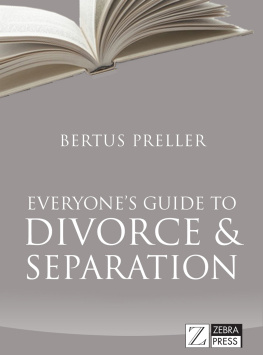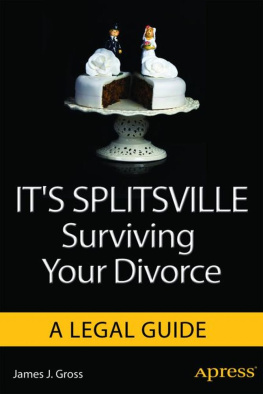Cochran - Reconcilable Differences
Here you can read online Cochran - Reconcilable Differences full text of the book (entire story) in english for free. Download pdf and epub, get meaning, cover and reviews about this ebook. year: 2007, publisher: Second Story Press, genre: Home and family. Description of the work, (preface) as well as reviews are available. Best literature library LitArk.com created for fans of good reading and offers a wide selection of genres:
Romance novel
Science fiction
Adventure
Detective
Science
History
Home and family
Prose
Art
Politics
Computer
Non-fiction
Religion
Business
Children
Humor
Choose a favorite category and find really read worthwhile books. Enjoy immersion in the world of imagination, feel the emotions of the characters or learn something new for yourself, make an fascinating discovery.

- Book:Reconcilable Differences
- Author:
- Publisher:Second Story Press
- Genre:
- Year:2007
- Rating:3 / 5
- Favourites:Add to favourites
- Your mark:
- 60
- 1
- 2
- 3
- 4
- 5
Reconcilable Differences: summary, description and annotation
We offer to read an annotation, description, summary or preface (depends on what the author of the book "Reconcilable Differences" wrote himself). If you haven't found the necessary information about the book — write in the comments, we will try to find it.
Separation and divorce can be a grueling and cruel experience. Spouses who once loved each other can be swept up by an adversarial system where they declare war on each other, forgetting all that was good between them and disregarding the needs...
Reconcilable Differences — read online for free the complete book (whole text) full work
Below is the text of the book, divided by pages. System saving the place of the last page read, allows you to conveniently read the book "Reconcilable Differences" online for free, without having to search again every time where you left off. Put a bookmark, and you can go to the page where you finished reading at any time.
Font size:
Interval:
Bookmark:
Reconcilable Differences Marriages end. Families don't.
Marriages end. Families don't.
Gate Cochran
with Janet Douglas Gochran

Library and Archives Canada Cataloguing in Publication
Cochran, Gate, 1955
Reconcilable differences : marriages end, families don't /
by Gate Cochran.
ISBN 978-1-897187-39-6
1. Divorced parentsCanada. 2,. Children of divorced parents
Canada. 3. Broken homesCanada. 4. FamilyCanada. I. Title.
HQ8i4,.C62 2007 306.890971 03007-903518-3
Copyright 2007 by Gate Cochran
First published in the USA in 2008
Cover design by Gate Cochran
Cover and Chapter 10 illustration Joseph Sherman
Author photo Edward Gajdel
Text design by Melissa Kaita
Printed on 100% post-consumer recycled paper
(Ancient Forest Friendly, FSC Certified)
Printed and bound in Canada Second
Story Press gratefully acknowledges the support of the Ontario Arts
Council and the Canada Council for the Arts for our publishing program. We
acknowledge the financial support of the Government of Canada through the Book Publishing Industry Development Program.

Published by
S ECOND S TORY P RESS
20 Maud Street, Suite 401
Toronto, Ontario, Canada
M5V2M5
www.secondstorypress.ca
To Joe, Maddie and Jake
And to my mother,
Janet Douglas Cochran
CHAPTER ONE |
CHAPTER TWO |
CHAPTER THREE |
CHAPTER FOUR |
CHAPTER FIVE |
CHAPTER SIX |
CHAPTER SEVEN |
CHAPTER EIGHT |
CHAPTER NINE |
CHAPTER TEN |
WHEN I SPLIT UP WITH MY HUSBAND , one thing was certain: I did not want a crash-and-burn separation. Neither did he. We had friends whose marriages had disintegrated into rancor and vitriol; one couple's angry divorce dance became so animated it completely overshadowed their new lives. My husband and I vowed we would never allow that to happen to us. It seemed like a reasonable decision at the time. Later we realized how profoundly important that commitment would be.
When you stand on the threshold of a separation, it's like being at the edge of a forest fire. What you see and feel is intense heat, turmoil, and a force that appears beyond your control a dangerous place, full of fear and loss. Emotions are in flux, there are major financial and legal issues to resolve and custody arrangements to be negotiated. There is so much to do, all in the midst of painful circumstances. But ending a marriage need not devastate a family. You don't have to destroy your children or your relationship with your former spouse. The family that remains doesn't have to be broken.
![]()
A forest fire seems to destroy everything in its path, but within three months, new life emerges from the charred forest floor. It takes time, but the forest re-establishes itself, and families can, too. I know this because I've been there. As I've learned, others have too. None of us wants to go through a divorce, but sadly, at least half of all marriages fail. The expectation is that it will be a hellish experience in which we and the person we once loved become adversaries and forget all that drew us to each other in the first place, but as the couples in this book show us, it doesn't have to be that way.
You'll see from their stories that it is possible to recon-figure a family so that it's functional and happy and loving. It will take time and patience, and sometimes the task will be extremely challenging. But once everyone regains their balance and emotions become calmer, you can transcend what did not work, preserve what did, and create something new that better meets everyone's needs. It will look and feel different, but that's okay.
Which is not to say it's an easy process to separate amicably. My husband and I hit many rough spots as we began to reorganize the life that we'd shared for almost twenty years. There were times, lots of them, when we could have blown the family apart, but we didn't. Instead, we held close the belief that we could rebuild a dysfunctional marriage into a functioning family, and we did.
Sometimes support for our efforts was a little thin. Some in the outside world told us we were being naive or downright foolish. Books I read by experts predicted dire consequences for our children, which was both demoralizing and frightening. There were endless tales about how far wrong people could go in ending their marriages, but there were no mentors, no guides, and no reference texts for what we were trying to do. We had to invent our own rules every step of the way, and sometimes the odds against us seemed high.
In our separation, inspiration came from an unexpected source: I loved playing house. As a toddler, I used to play with saucepans and preserving jars, pretending the pans were houses, the jars little grown-ups, and the lids the jar-people's children. I'd take them to my bedroom at nap time, arrange them in families, and create scenarios about who belonged where, who lived with whom, and what all these people were doing together. When I was a little older, I'd get into bed at night, shake out my blanket, and watch as it settled into place over my legs. How it landed determined the topography of my stories. Its wrinkles were the walls of buildings that I'd populate with tiny pretend people mothers and fathers and two or three childrenbecause that's how I thought families looked. They'd talk and negotiate, growup, get married, have babies, raise families, and sometimes even die. They lived on that woolen stage night after night, and each time I threw my blanket in the air a new world would fall in my lap.
As I grew up, my childhood game evolved into an ongoing curiosity about why and how people choose to live together. When I was thirty, I read a magazine article about American mystery writer Robert B. Parker and his wife, writer Joan H. Parker, who survived the breakdown of their marriage by buying a fourteen- room house with two apartments one for him, one for her. Living in their own separate spaces, they were able to sidestep conflicts and renew their relationship. I loved the idea that they could choose when they wanted to be together, arranging to go on dates or inviting each other for dinner.
Then I heard about Canadian gardening writer Marjorie Harris and her husband, writer Jack Batten, who had restructured their lives after a difficult separation. When they reconciled, they dated for a while, then decided to share one house again after they wearied of shuttling between two homes and carrying two mortgages. They adopted an upstairs -downstairs arrangement, in which each had a separate apartment. The solution was unorthodox but workable, and they were happy. Both of these ideas seemed like good arrangements for a marriage, and I used to joke with my husband that we should move into side-by-side duplexes.
Next pageFont size:
Interval:
Bookmark:
Similar books «Reconcilable Differences»
Look at similar books to Reconcilable Differences. We have selected literature similar in name and meaning in the hope of providing readers with more options to find new, interesting, not yet read works.
Discussion, reviews of the book Reconcilable Differences and just readers' own opinions. Leave your comments, write what you think about the work, its meaning or the main characters. Specify what exactly you liked and what you didn't like, and why you think so.








